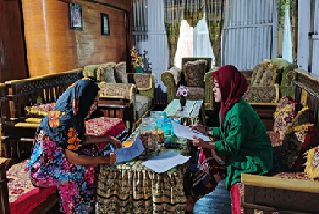Enhancing household iodized salt practices through contextual health education
An intervention study in rural Jeneponto, Indonesia
DOI:
https://doi.org/10.24252/sociality.v4i2.59863Keywords:
cipp model, community health, iodine deficiency, iodized salt, rural educationAbstract
Iodine deficiency remains a significant nutritional issue in Indonesia, particularly affecting rural communities with limited access to accurate health information. This research-based community engagement aimed to evaluate the effectiveness of an educational intervention on household knowledge and practices related to iodized salt usage in Bontobakka Hamlet, Jeneponto Regency. The intervention employed a door-to-door campaign using poster media and involved 31 female respondents who were assessed at three time points: pre-intervention, post-intervention, and six months post-intervention. The study utilized a summative evaluative approach based on the CIPP model (Context, Input, Process, Product) to measure program impact. The Friedman test revealed a statistically significant improvement in knowledge levels (p = 0.028), with 87.1% of participants achieving a "good" knowledge score at the final assessment. Integration of religious values through Q.S. Al-Baqarah: 168 enhanced community acceptance, demonstrating the importance of culturally sensitive messaging. The findings underscore the value of combining visual, contextual, and faith-based strategies to promote iodized salt consumption and address Iodine Deficiency Disorders (IDD) in rural Indonesia.
References
Alam, S. (2023). Nutritional status, physical activity, and fluid intake with dehydration status of farmers in Jeneponto Regency. Al-GIZZAI: Public Health Nutrition Journal, 3(1). Retrieved from https://journal3.uin-alauddin.ac.id/index.php/algizzai/article/view/35768
Alam, S., & Adnan, Y. (2021). Eating pattern and educational history in women of childbearing age. Al-Sihah: The Public Health Science Journal, 12(1), 81–91. https://doi.org/10.24252/AL-SIHah.V12I1.15233
Alam, S., Wijaya, D. R., Kurniawan, A., & Maesarah, M. (2024). Exploring factors influencing diabetes mellitus incidence among participants of chronic disease management program in rural areas. Al-Sihah: The Public Health Science Journal, 16(1), 69–80. https://doi.org/10.24252/al-sihah.v16i1.48131
Aulia, R., Yaswinda, Y., & Movitaria, M. A. (2022). Penerapan model evaluasi CIPP dalam mengevaluasi penyelenggaraan lembaga PAUD tentang pendidikan holistik integratif di Nagari Taram. Jurnal Inovasi Penelitian, 2(8), 2363–2372.
Balitbangkes. (2018). Laporan nasional Riskesdas tahun 2018. Badan Penelitian dan Pengembangan Kesehatan, Kementerian Kesehatan Republik Indonesia.
Damanik, Y. S. (2019). Hubungan pengetahuan dan sikap ibu rumah tangga dengan penggunaan garam beryodium. Jurnal Penelitian Kesmasy, 1(2), 54–57. https://doi.org/10.36656/jpksy.v1i2.166
Kementerian Kesehatan Republik Indonesia. (2019). Rencana aksi kegiatan 2015–2019. Balai Penelitian dan Pengembangan GAKY.
Kusmita, A., & Mandagi, A. M. (2021). Gambaran penggunaan garam beryodium di Desa Telemung Kecamatan Kalipuro Kabupaten Banyuwangi. Preventia: The Indonesian Journal of Public Health, 6(1), 7–12. https://doi.org/10.17977/um044v6i1p7-12
Nurhayati, N., Irwan, I., & Miko, A. (2021). Penyuluhan garam beryodium terhadap perubahan pengetahuan ibu rumah tangga dalam penggunaan garam yodium. Jurnal SAGO Gizi dan Kesehatan, 2(2), 178–183. https://doi.org/10.30867/gikes.v2i2.490
Nurjaya, A., Aslinda, W., & Astuti, N. S. K. S. (2019). Analysis of iodine content in salt iodization in plastic and glass storage containers for 6 days of storage. Poltekita: Jurnal Ilmu Kesehatan, 13(1), 25–29.
Rasikawati, I., & Sulistyadewi, N. (2020). Efektivitas sosialisasi garam beryodium terhadap penggunaan garam beryodium secara mandiri di wilayah kerja Puskesmas Baturiti I Kabupaten Tabanan. Jurnal Kesehatan Terpadu, 3(2), 47–52. https://doi.org/10.36002/jkt.v3i2.973
Syahraini. (2020). Edukasi tentang sumber pangan lokal dan garam beryodium melalui poster. Jurnal Ghidza, 7(1), 34–40.
Tasya Indriana, N. S. (2021). Pemanfaatan garam beryodium oleh ibu rumah tangga di desa. Jurnal Sains dan Aplikasi, 4(2), 78–83.
Wulandari, K. P., & Sutiari, N. K. (2023). Pengetahuan dan persepsi ibu rumah tangga dengan penggunaan garam beryodium: Studi cross-sectional di Tampaksiring. Jurnal Ilmu Kesehatan Masyarakat Indonesia, 10(1), 1–9.

Downloads
Published
How to Cite
Issue
Section
License
Copyright (c) 2025 Syamsul Alam, Nur Rahmah, Zilfadhilah Arranury, Ahmad Fauzan, Nur Meliyanti, Dwi Febriayu, Ardiansyah Ardiansyah

This work is licensed under a Creative Commons Attribution-NonCommercial-ShareAlike 4.0 International License.

